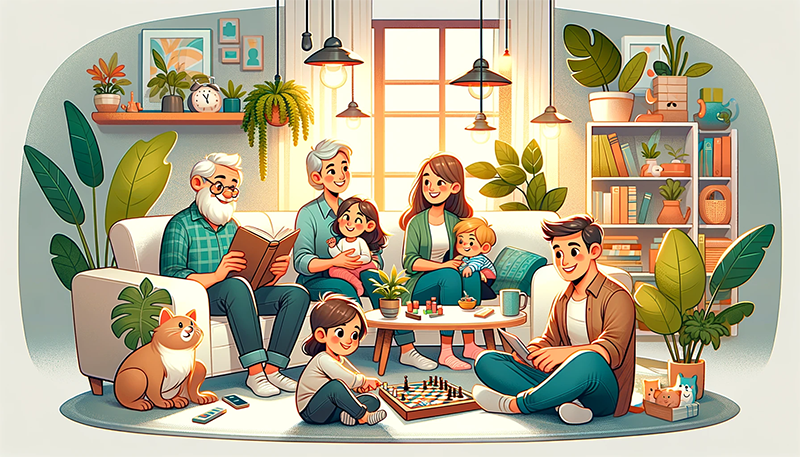Every family is unique, with its own set of dynamics, challenges, and personalities. However, one thing that remains constant is the desire for happiness and well-being within the family unit. In today’s fast-paced world, it’s easy to get caught up in the hustle and bustle of daily life and neglect the very relationships that bring us joy and fulfillment. But fear not! With a few simple strategies, you can cultivate a culture of happiness and harmony within your family.

1. Practice Gratitude
The old adage "count your blessings" holds more truth than you might think. Studies have shown that practicing gratitude can have a significant impact on our overall happiness. Take a few minutes each day to reflect on the good things in your life, no matter how small they may seem. Encourage your family members to do the same. You can even make it a fun activity by creating a gratitude jar, where everyone writes down something they’re thankful for and puts it in the jar.
2. Quality Time
In today’s digital age, it’s easy to get caught up in screens and neglect quality time with our loved ones. Set aside device-free time each day, where you can engage in activities that bring you joy together as a family. This could be anything from playing board games, cooking a meal together, or going for a walk. The key is to prioritize face-to-face interaction and create opportunities for meaningful connections.
3. Open Communication
Effective communication is the backbone of any healthy relationship. Create a safe and supportive environment where family members feel comfortable sharing their thoughts, feelings, and concerns. Practice active listening, and make sure to validate each other’s emotions. This doesn’t mean you have to agree on everything, but rather that you respect and understand each other’s perspectives.
4. Show Appreciation
A simple "thank you" or acknowledgement of someone’s efforts can go a long way in promoting happiness within the family. Make an effort to show appreciation for the little things, like helping with chores or cooking a meal. You can even create a reward system, where family members are recognized for their contributions.
5. Foster a Sense of Belonging
Every individual has a fundamental need to belong and feel part of something bigger than themselves. Create opportunities for family members to bond over shared interests or activities. This could be anything from starting a family book club, to participating in a charity event together.
6. Model Positive Behavior
As parents, you are your children’s most significant role models. It’s essential to model the behavior you want to see in your kids. Practice empathy, kindness, and understanding, and your children will be more likely to follow suit.
7. Create Family Traditions
Family traditions are an excellent way to create a sense of continuity and connection within the family. This could be anything from having a weekly family game night, to participating in a cultural celebration or holiday. Traditions provide a sense of stability and predictability, which can be particularly important for children.
8. Practice Forgiveness
No family is perfect, and conflicts are inevitable. However, it’s how you respond to these conflicts that can make all the difference. Practice forgiveness and understanding, and encourage your family members to do the same. Holding grudges can create a toxic environment, whereas forgiveness can lead to greater understanding and empathy.
9. Make Time for Fun
Laughter is the best medicine, after all! Make time for fun activities that bring joy to your family members. This could be anything from having a movie night, to going on a fun outing or adventure.
10. Prioritize Self-Care
Last but not least, prioritize self-care within the family. Encourage family members to take care of their physical, emotional, and mental well-being. When individuals are happy and fulfilled, they are more likely to contribute to a happy and harmonious family environment.
Frequently Asked Questions
Q: How can I get my kids to participate in family activities?
A: Make it fun and engaging! Involve your kids in the planning process, and choose activities that cater to their interests.
Q: What if my family is dealing with complex issues like mental health or addiction?
A: Seek professional help and support. A therapist or counselor can provide guidance and tools to help your family navigate challenging situations.
Q: How can I balance individual needs with family time?
A: Create a schedule that allows for both individual time and family activities. Communicate with your family members to ensure everyone’s needs are being met.
Q: What if my family is blended or non-traditional?
A: Focus on creating a sense of unity and belonging, regardless of your family’s structure. Celebrate your unique dynamics and create traditions that work for everyone.
Conclusion
Creating a culture of happiness within your family requires effort, commitment, and patience. By implementing these simple strategies, you can cultivate a sense of harmony, understanding, and connection within your family unit. Remember, every family is unique, and what works for one family may not work for another. Be flexible, adapt to your family’s needs, and prioritize open communication, empathy, and understanding.
By making these strategies a part of your daily life, you can create a happy, harmonious home where everyone feels seen, heard, and valued. So, take the first step today, and start cultivating the happiness and well-being that your family deserves!
Closure
Thus, we hope this article has provided valuable insights into The Art of Family Happiness: Strategies for a Harmonious Home. We appreciate your attention to our article. See you in our next article!